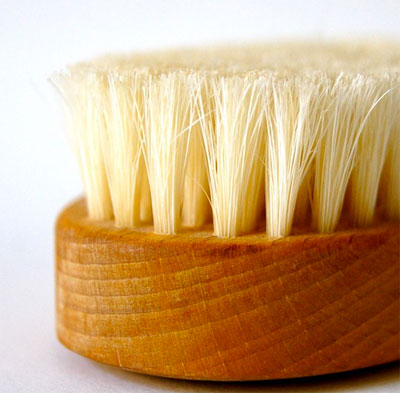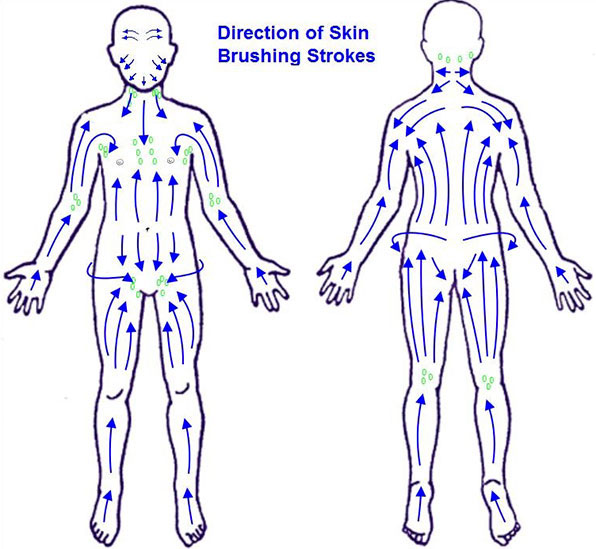One of the big reasons why people start dry brushing is to detox the lymphatic system. But how does it really work? What are the benefits?
Katie Wells of Wellness Mama lists “Lymphatic Support” as the first benefit of dry body brushing. She explains that “the lymphatic system is a major part of the body’s immune system”.
Advocates of skin brushing argue that a consistent brushing regimen can help promote the body’s normal lymph flow and therefore help the body detoxify naturally.
Lymphatic Brushing Techniques with Dr. Mindy Beck ND
In the video below, Dr. Beck shows specific lymphatic brushing techniques that we can use to help detox our bodies. In addition to benefiting the lymph system, this practice also calms the nervous system and supports cardiovascular function.
First, she recommends choosing a brush with natural bristles and using long gentle strokes. Move the brush toward the heart or the lymph node drainage area. (3/4 of the lymphatic system drains into left armpit area.)
Second, she says to pay special attention to the abdomen area. Since the abdomen contains 60-70% of our lymphatic tissue, we want to spend at least 60 seconds brushing there. Use a clockwise motion, starting from the right side.
Third, you don’t want to over-brush. In fact, you may want to begin slowly, such as a few days a week, before progressing to a daily routine. In addition, you want to be careful to avoid varicose veins, open cuts, sunburns, rashes etc..
How to Do Dry Brushing for Lymphatic System Health:
Here’s a step-by-step guide on how to perform dry brushing for lymphatic system health:
- Select the Right Brush: Opt for a brush containing natural bristles. Plus, you want an elongated handle for ease of reaching different body parts.
- Gentle Strokes: Begin brushing gently. Use long and smooth strokes, always moving towards the direction of the heart or lymph node areas. This aids in following the natural direction that lymph travels.
- Focus on Lymph Node Areas: Pay particular attention to zones where lymph nodes are dense, (ie. armpits, groin neck). Approximately 3/4 of the lymphatic system drains into the left armpit area.
- Prioritize the Abdomen: Allocate extra time to brush the abdomen as it houses a significant portion (about 60-70%) of lymphatic tissue. Use delicate circular motions, initiating from the right side and moving in a clockwise direction. This mimics the natural flow of the digestive system and supports lymphatic drainage.
- Start Gradually: If you’re new to dry brushing, ramp up slowly. For instance, start with 2-3 days a week, gradually progressing to a daily regimen.
- Avoid Sensitive Areas: Take care near sensitive or damaged skin, varicose veins, open cuts, sunburns, rashes, or areas of irritation.
- Post-Brushing Care: Follow up dry brushing with a shower to wash away the loosened dead skin cells. Apply a moisturizer to keep the skin hydrated and healthy.
What About a Lymphatic System Detox?
In her book, The Hormone Secret, Discover Effortless Weight Loss and Renewed Energy in Just 30 Days, Dr. Tami Meraglia MD shares that “Your skin absorbs toxins and chemicals, and dry brushing helps the skin’s detoxification abilities”. She even recommends doing dry skin brushing exfoliation once a day during a cleanse to help stimulate the lymphatic system.
Dry Brushing VS Lymphatic Drainage Massage:
Dry brushing for lymphatic drainage involves dragging a soft body brush along the skin, stimulating lymph circulation. Lymphatic drainage massage is a hands-on technique performed by a trained therapist, manually manipulating lymph nodes to encourage lymph movement. Both aim to support lymphatic system function but differ in approach and depth of manipulation.
How Dry Brushing Can Also Help Heal the Adrenals
Dr. Alan Christianson is also a big proponent of therapeutic skin brushing due to its capacity to “reset” the adrenals.
As Dr. Beck mentioned above, lymphatic brushing can help calm the nervous system. Well, the adrenal glands are also affected by the nervous system.
Even More Health Benefits…
Since tactile nerves lay right underneath the skin, body brushing can calm the brain, lower stress hormones and help regulate cortisol. As a result, results show people sleeping better, losing weight more easily and having boosted energy.
Another home-based option that is growing in popularity is using a vibration platform. These machines cost more than a dry brush, but they also provide other health benefits. For example, they can help strength bones, boost metabolism, improve flexibility and decrease stress.
Below, Dr. Christianson shares an insightful and somewhat controversial opinion of achieving better hormonal health via simple dry brushing techniques. Instead of relying on medication, why not soothe, calm and heal the body as a way to better health?
Dry Brushing for Lymphedema:
Just like it promotes toxin flushing by stimulating the lymphatic system, body brushing can help with lymphedema.
Some users recommend carrying out your brushing routine right after you wake in the morning. You also want to establish a consistent practice, which will get your better results.
Consequently, you want to use a softer brush versus coarser bristles and apply minimal pressure. For example, a rough brush used frequently may agitate the skin and produce more problems than benefits.
Pros & Cons of Dry Brushing for Lymphatic Drainage:
Dry Brushing Benefits:
- Lymphatic Stimulation: Dry brushing involves gentle brushing of the skin with a natural-bristled brush, which can help stimulate the lymphatic system. This can potentially improve lymphatic flow, aiding in the removal of toxins and waste from the body.
- Exfoliation: Dry skin brushing can exfoliate by sloughing away dead skin cells. Consequently, skin can feeling silkier and softer.
- Improved Circulation: The act of dry brushing can also accelerate blood flow, which may in turn contribute to healthier circulation and skin tone.
- Invigorating: Many people find dry brushing to energize and invigorate, particularly when performed in the morning. It can help wake up the body and mind.
Drawbacks of Lymphatic Skin Brushing:
- Skin Sensitivity: Individuals with highly sensitive skin or skin conditions like eczema or psoriasis may not react well to dry brushing. In addition, this technique can cause irritation, redness or even abrasions if done too vigorously.
- Risk of Injury: If not done properly, aggressive or harsh brushing can damage the skin, causing microtears or irritation.
- Lack of Scientific Evidence: While many people claim benefits from dry brushing, scientific evidence supporting its effectiveness in detoxifying the body is limited.
- Potential Discomfort: Dry brushing might cause discomfort or pain if the brush bristles are too rigid or if excessive pressure is applied. Individuals may experience sensitivity or unpleasant sensations during the process.
- Not a Standalone Solution: Dry brushing shouldn’t be relied upon as the exclusive method for detoxification or overall health improvement. It’s most effective when incorporated into a comprehensive wellness routine that includes proper nutrition, adequate hydration, regular exercise, and other healthy lifestyle habits.
In Summary:
Dry brushing involves gentle strokes on the skin with a natural-bristled brush, potentially stimulating the lymphatic system and improving circulation. Advocates report that the benefits of dry brushing for lymphatic drainage include toxin removal, exfoliation and potential support for adrenal health.
However, scientific evidence supporting its detoxification effects remains limited. Caution is advised for individuals with sensitive skin, as harsh brushing may cause irritation. It’s also best considered as part of a broader wellness routine rather than a standalone solution.


